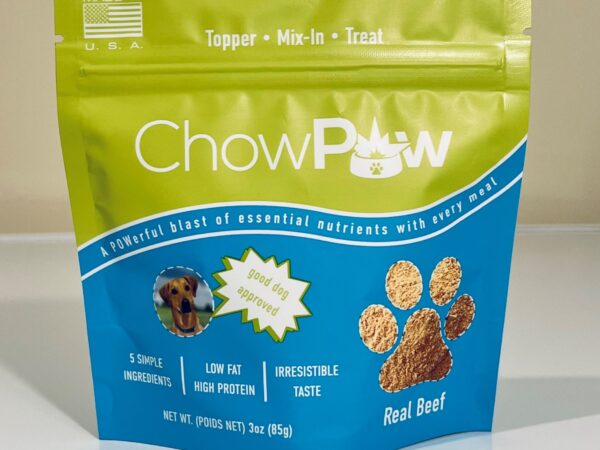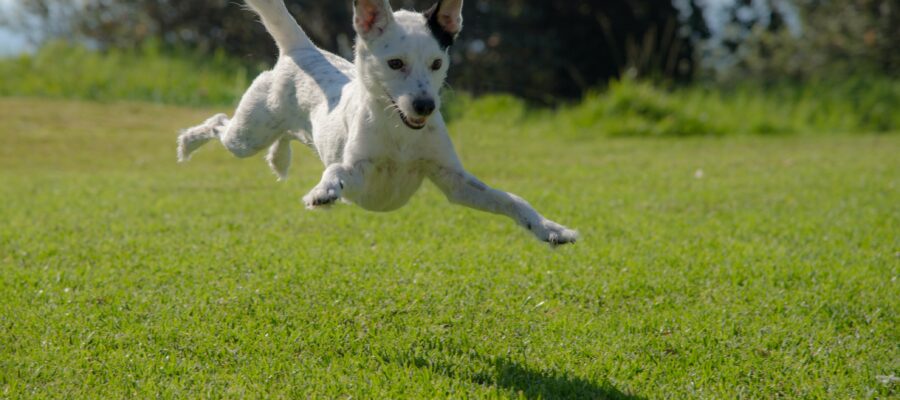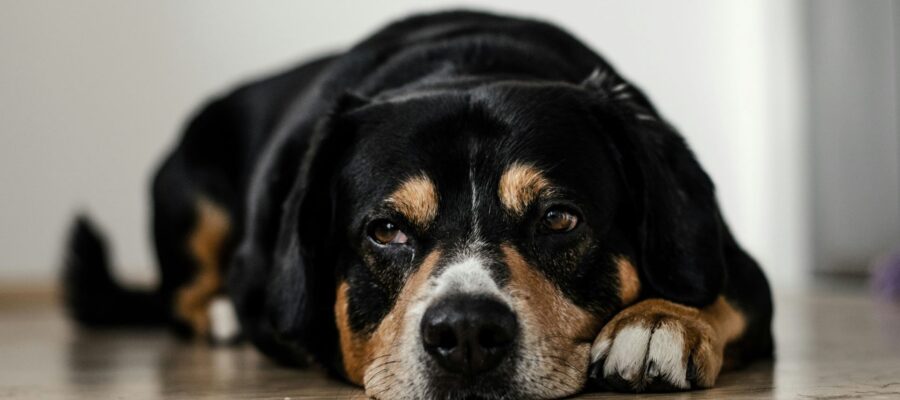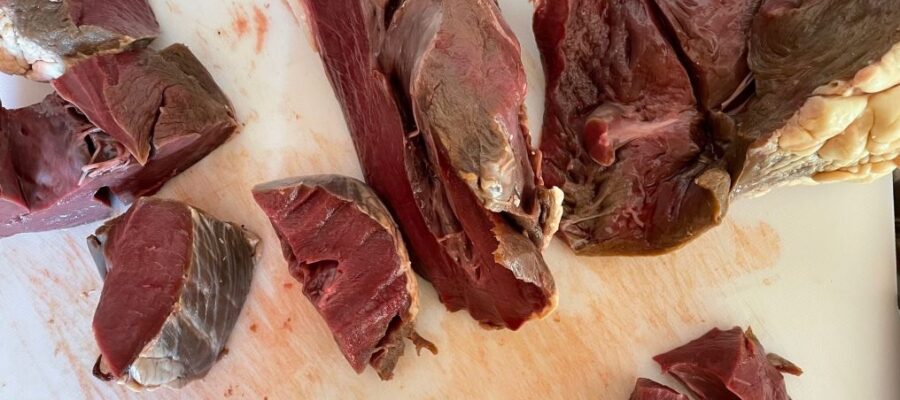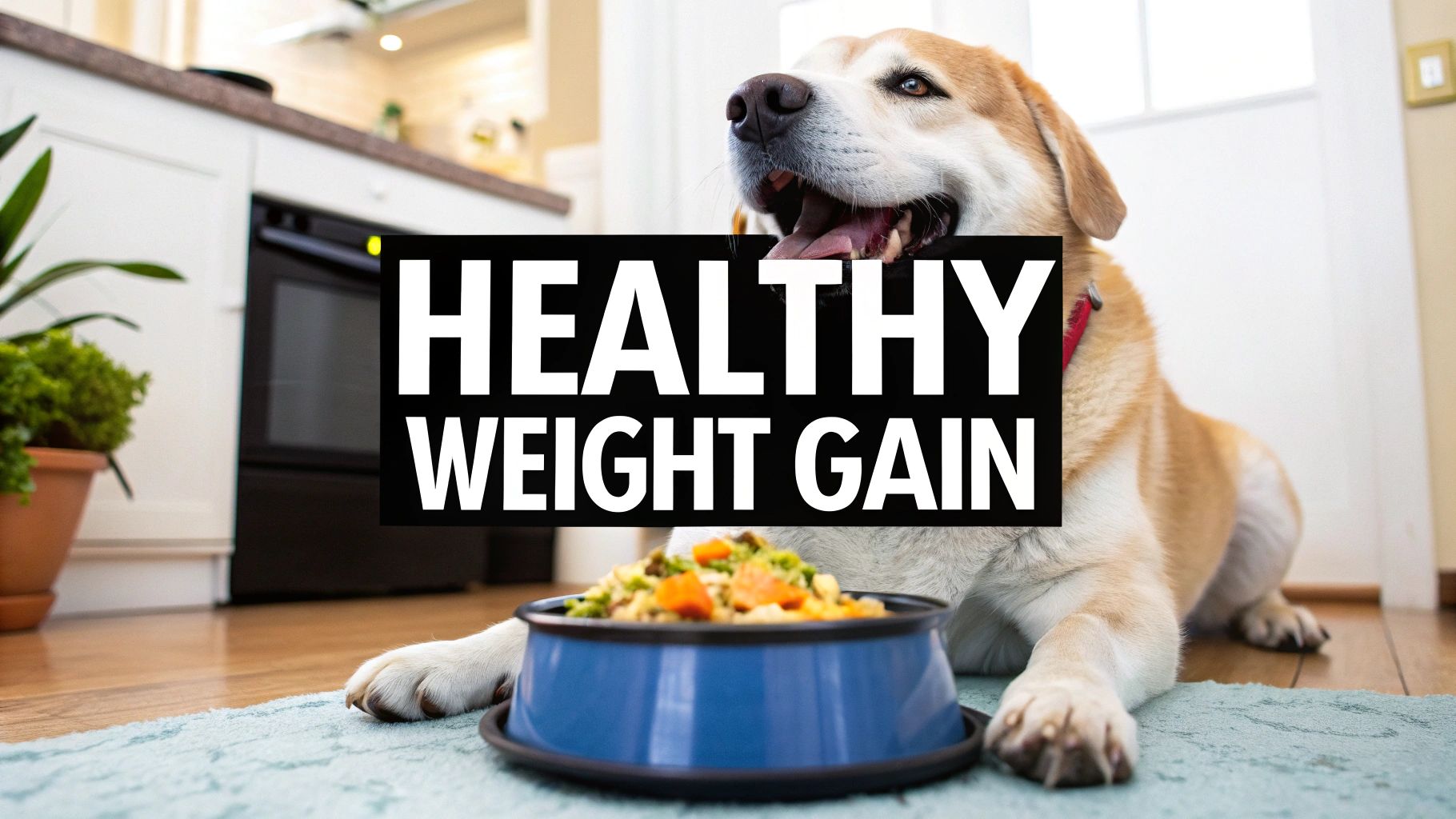
The Best Way to Put Weight on a Dog
When you first notice your dog is looking a little too lean, it’s a genuinely worrying sight. Seeing their ribs, spine, or hip bones more clearly than before can set off alarm bells for any loving owner.
Your first instinct might be to just start piling more food into their bowl. It seems logical, right? But hitting the pause button and investigating why they’re losing weight is a much safer, more effective starting point. Simply adding more kibble can mask a serious underlying issue.
Think of it this way: successfully helping your dog gain weight is all about understanding the root cause. Skipping the diagnostic part is like trying to fix a leaky pipe by just mopping the floor—you’re only dealing with the symptom, not the source of the problem.
Start with an At-Home Check
Before you even pick up the phone to call the vet, you can get a better handle on the situation at home. The best way to do this is with a Body Condition Score (BCS) assessment. This isn’t about the number on the scale; it’s a hands-on method to evaluate their actual body composition.
Gently run your hands over their ribs. Look down at them from above—can you see a defined waist? Now look at them from the side—is there a clear “tummy tuck”? For a dog at a healthy weight, you should be able to easily feel their ribs under a thin layer of fat, but not necessarily see them.
If those ribs, along with their spine and hip bones, are sharp to the touch and highly visible with no fatty padding, it’s a clear sign your dog is underweight. This quick check gives you specific, concrete observations you can share with your vet.
To help you get started, here’s a quick reference table. It’s a simplified way to perform an initial check at home before your vet appointment.
Quick Guide to Assessing Your Dog’s Body Condition
| Body Condition Score | What You See & Feel | What It Means |
|---|---|---|
| Too Thin (1-3) | Ribs, spine, and hip bones are highly visible from a distance. No discernible body fat. Obvious loss of muscle mass. | Your dog is underweight and needs a veterinary evaluation to determine the cause and create a weight gain plan. |
| Ideal (4-5) | Ribs are easily felt but not seen, with a slight fat cover. Waist is visible from above. Abdominal tuck is present. | Your dog is at a healthy weight. Keep up the great work with their diet and exercise! |
| Too Heavy (6-9) | Ribs are difficult to feel under a thick layer of fat. No visible waist. Abdominal tuck is absent or minimal. | Your dog is overweight, which can lead to health problems. A weight management plan from your vet is recommended. |
Remember, this table is just a guide. A professional veterinary exam is the only way to get a definitive assessment of your dog’s health.
Why a Vet Visit is Non-Negotiable
That at-home check is a fantastic starting point, but it’s no substitute for a professional diagnosis. Unexplained weight loss is often a major red flag for hidden health problems that need medical attention, not just more calories. Your vet will perform a full physical exam and might run some tests to look for common culprits.
Some of the usual suspects include:
- Dental Pain: A sore tooth or infected gums can make chewing unbearable, causing a dog to avoid eating.
- Internal Parasites: Pesky intestinal worms can steal vital nutrients right from your dog’s food, leading to weight loss even with a normal appetite.
- Metabolic or Digestive Issues: Conditions like thyroid problems, diabetes, or Inflammatory Bowel Disease (IBD) can seriously mess with how your dog absorbs and uses calories.
- Stress or Anxiety: Big changes at home, like a move or a new pet, can cause enough stress to kill their appetite. If you think stress might be the issue, you might want to learn about the top signs that your dog needs a meal supplement.
A professional diagnosis is the absolute cornerstone of any safe weight gain plan. Without it, you could waste time and money on diet changes that don’t work or, far worse, let a serious medical condition go untreated.
Understanding the Caloric Gap
Once your vet has given your dog a clean bill of health, the conversation can finally turn to nutrition. Putting on healthy weight is a numbers game—specifically, a calorie game.
It’s a delicate balance. You need to provide enough high-calorie, nutrient-dense food to help them gain weight safely, without pushing them too far into obesity. This is a real concern in places like the United States and the United Kingdom, where obesity rates in dogs are shockingly high (56% and 51%, respectively). It’s why working with a vet to create a targeted plan is so important. You can find more on these findings on canine nutrition and health here.
The chart below gives a great visual of what we’re talking about—the “caloric gap” that often exists for an underweight dog.
As you can see, this dog is consuming 300 fewer calories per day than what’s needed just to maintain a healthy weight. This is the deficit we need to close, and we’ll do it with a carefully planned, nutrient-rich diet.
Building the Right High-Calorie Diet
Once your vet gives you the all-clear on underlying health issues, you can shift your focus to the most powerful tool in your arsenal: nutrition. Putting healthy weight on a dog isn’t about just piling more food into their bowl. It’s about making every single calorie count, safely and sustainably.
The real goal is to provide a diet packed with high-quality, easily digestible nutrients that support healthy weight gain—meaning lean muscle, not just fat. This all comes down to a careful balance of the big three macronutrients.
The Essential Trio: Protein, Fat, and Carbs
To get this right, you have to understand what each component brings to the table. A balanced approach is what ensures your dog gets everything they need to rebuild their strength.
- High-Quality Protein: This is the absolute foundation for rebuilding lost muscle. Look for foods where a named animal protein, like beef, chicken, or fish, is the very first ingredient. Protein provides the essential amino acids needed to repair tissues and build a strong, lean body.
- Healthy Fats: Here’s your calorie powerhouse. Fats pack more than double the calories per gram compared to protein or carbs, making them vital for weight gain. But quality is key. Healthy fats from sources like fish oil or high-quality animal fat also do wonders for their skin, coat, and joints.
- Easily Digestible Carbs: Think of carbs as the quick-energy source that lets protein do its main job of muscle repair. We recommend wholesome, gentle sources like sweet potatoes or pumpkin that are easy on the stomach and provide sustained energy without the filler.
Finding the right balance is crucial. Piling on too much fat can lead to an upset stomach, while skimping on quality protein means your dog won’t have the building blocks they need.
Nutrient Density Over Sheer Volume
Just dumping more of your dog’s current food into their bowl can seriously backfire. For a dog with a low appetite or a sensitive stomach, a huge meal is overwhelming and can lead to digestive upset or them turning their nose up at it altogether.
A much smarter strategy is to focus on nutrient density. This means every scoop of food is packed with more calories, protein, and fat. A nutrient-dense diet lets your dog get the calories they need in a smaller, more manageable portion, which is often the best way to add weight without causing distress.
It might seem strange, but helping a dog gain weight requires careful management to avoid overshooting the mark. A staggering 59.3% of dogs are considered overweight or obese, which really highlights the importance of sticking to a controlled, vet-approved plan.
Why a Food Topper Is a Smart Foundation
This is exactly where a specialized, high-calorie food topper like ChowPow can make all the difference. We specifically designed ChowPow to boost the nutritional value of your dog’s existing food, turning a standard meal into a powerhouse of targeted calories and nutrients.
It’s incredibly effective because of its simple, high-impact ingredient list. By using just a few powerful ingredients, ChowPow delivers exceptional nutritional value without any of the unnecessary fillers that can upset a sensitive system.
The formula is built around dehydrated beef heart—an incredibly nutrient-dense protein that’s rich in taurine and essential amino acids for muscle development. Adding just a scoop to your dog’s kibble directly increases the protein and fat content without adding a ton of extra volume. For more ideas, you can check out our guide on the best dog food toppers for weight gain.
How ChowPow Supports Healthy Weight Gain
We engineered ChowPow to do more than just add calories. Its unique, simple formula provides several key benefits for any dog on a weight gain journey.
Key Benefits of Using ChowPow:
- High Palatability: The rich, meaty aroma of beef heart is irresistible to most dogs. This is a huge advantage when you’re dealing with a picky eater or a dog whose appetite has faded. It gets them excited to eat.
- Concentrated Nutrition: Because it’s a dehydrated powder, the nutrients are highly concentrated. A small amount delivers a significant boost of high-quality protein and healthy fats.
- Gentle on Digestion: The formula skips common fillers like corn, wheat, and soy that can cause digestive issues. With simple, whole-food ingredients, it supports gentle digestion while adding vitamins and minerals.
- Supports Muscle Development: The main ingredient, beef heart, provides the critical building blocks for repairing and growing lean muscle, ensuring your dog gains healthy, functional weight.
Incorporating a topper like ChowPow is a practical and effective way to ensure your dog’s diet is optimized for weight gain. It simplifies the process and gives you confidence that you’re providing the targeted nutrition they need to thrive.
Smart Feeding Strategies for Relucant Eaters
Crafting the perfect high-calorie diet is a huge step, but what good is it if your dog turns their nose up at it? If you have a picky eater on your hands, mealtime can turn into a daily battle of wills. The secret isn’t about forcing them to eat more; it’s about making their food downright irresistible.
This is where a few smart feeding strategies can make all the difference. With a couple of thoughtful adjustments, you can help shift your dog’s perspective on food and turn mealtime into a positive routine that actually supports healthy weight gain.
Ditch the Two-Meal-a-Day Mindset
For an underweight dog, a huge bowl of food can be completely overwhelming. Their stomach might be small or their digestive system a bit sluggish, making a large portion feel like an impossible task. So, let’s rethink the traditional two-meals-a-day schedule.
Try breaking their daily food ration into three or four smaller, more frequent meals. It’s much gentler on their system and keeps their energy from crashing between feedings. A smaller meal is way less intimidating and actually encourages your dog to clean their bowl without feeling uncomfortably full.
Make Every Meal an Experience
Think about it: the smell of warm, freshly baked bread is far more tempting than a cold slice. The same logic applies to your dog’s food. Gently warming up their meal is one of the simplest tricks in the book to spark their interest.
A little heat releases the food’s natural aromas, which can be a game-changer for a dog with a low appetite. You can easily do this by adding a splash of warm water or some low-sodium bone broth to their bowl. Plus, the extra moisture softens dry kibble, which is a huge bonus for older dogs or pups with sensitive teeth.
A predictable and positive mealtime routine is just as crucial as the food itself. Serving their food in a calm, quiet space helps lower any anxiety they might feel, letting them focus on eating without distractions.
Elevate the Flavor and Appeal
If a little warmth isn’t cutting it, it’s time to bring in the big guns: flavor enhancers. This is where a high-quality food topper like ChowPow really comes into its own. The rich, meaty smell of dehydrated beef heart is a powerful appetite stimulant that can make even the most boring kibble seem exciting.
Beyond a dedicated topper, you can mix in other healthy goodies to get them interested. Here are a few ideas that have worked for us:
- A Splash of Broth: A few tablespoons of warm, low-sodium chicken or bone broth creates a savory gravy that coats their kibble.
- A Spoonful of Goodness: Try mixing in a little plain canned pumpkin (not pie filling!) or cooked sweet potato for extra flavor and fiber.
- High-Value Meat: A small amount of unseasoned, cooked lean meat like shredded chicken can convince almost any picky eater to take a bite.
The goal here is to use these as flavor boosters, not the main course. You just want to add enough to pique their curiosity so they’ll eat their nutritionally balanced food. You can learn more about how toppers like ChowPow transform meals on the ChowPow website.
Create a Calm Feeding Sanctuary
Finally, take a look at where your dog eats. A busy, noisy kitchen with constant foot traffic can be incredibly stressful, especially for an anxious dog who might feel too vulnerable to settle down and eat.
Try moving their bowl to a quiet corner where they won’t be disturbed. Creating a safe, predictable “feeding sanctuary” gives them the peace they need to relax and focus on their meal. Consistency is your best friend—feeding them in the same calm spot at the same times every day helps build a routine they can rely on. These small tweaks are often the key to helping a dog with a poor appetite finally start gaining weight.
Building Muscle, Not Just Fat, With the Right Exercise
Exercising a dog you’re trying to put weight on might feel a little backward. But trust us, this is one of the most misunderstood—and most important—parts of a healthy weight gain plan.
Our goal isn’t just to see the number on the scale go up. It’s to build strong, functional, lean muscle. Without some gentle, targeted movement, all those extra calories can unfortunately turn into unhealthy fat instead of the muscle mass your dog needs.
Think of it less like a weight-loss program and more like body conditioning. The right kind of exercise ensures your dog’s new weight is supportive, strong, and genuinely improves their quality of life.
Why the Right Kind of Movement Matters
Not all exercise is created equal, especially when your dog is underweight and needs to rebuild. Intense, high-impact activities like long-distance running or a frantic game of fetch can actually work against you. They burn way too many calories and can leave a recovering dog too wiped out to even eat properly.
Instead, we need to shift our focus to low-impact, muscle-building activities. These exercises are all about promoting strength and conditioning without putting a ton of strain on their joints or burning through those precious calories you’re working so hard to add.
Crafting a Muscle-Focused Routine
For a dog that’s underweight, consistency trumps intensity every time. The key is to start slow and build a gentle routine that allows them to rebuild strength at a safe, comfortable pace. Always begin with short sessions and only increase the duration as you see them getting stronger and more energetic.
Here are a few of our favorite low-impact exercises to get started:
- Brisk Leash Walks: A controlled walk is perfect for building up both endurance and muscle tone. Start with just 10-minute walks and gradually work your way up to 20 or 30 minutes as their stamina improves. A steady, brisk pace is what you’re after.
- Gentle Incline Walking: Got a gentle hill nearby? Walking up a slight incline is fantastic for engaging the muscles in their hind legs, an area where underweight dogs often lose a lot of mass.
- Swimming: This is the gold standard if you can manage it. Whether it’s a safe lake or a canine hydrotherapy pool, swimming provides a full-body workout with zero impact on their joints. It’s ideal for dogs who are weak or have any joint sensitivity.
When you’re planning an exercise session, the goal is conditioning, not exhaustion. A great rule of thumb is to end the activity while your dog still has some gas left in the tank. This keeps things positive and makes them excited for the next session.
What to Hold Off On for Now
Knowing what not to do is just as critical. You need to steer clear of anything that could cause injury or serious fatigue while your dog is in this vulnerable, rebuilding phase.
Activities to temporarily pause:
- High-Impact Jumping: That means no frisbee or leaping high to catch toys.
- Long-Distance Running: Save the marathon training for later. It’s too strenuous and burns far too many calories right now.
- Roughhousing with Other Dogs: Unpredictable, rough-and-tumble play is too intense and carries a risk of injury.
Once your dog is back to a healthy weight and has rebuilt their strength, you can slowly and carefully reintroduce some of these more vigorous activities.
For now, a gentle, structured approach will get you the best results. You can find more safe ideas in our guide to the top indoor and outdoor options to exercise your dogs. Combining a calorie-dense diet with smart, muscle-building exercise is the surest path to helping your dog regain strong, healthy weight.
How to Track Progress and Adjust Your Plan
Helping your dog gain weight is a slow dance, not a race to the finish line. Once you have a solid nutrition and exercise plan in place, your role shifts to that of a careful observer. Watching your dog’s progress closely is the only way to know what’s working and when to make small, smart adjustments for healthy, sustainable weight gain.
Think of yourself as your dog’s personal health coach. You’re not just scooping food into a bowl; you’re monitoring their response to it, celebrating the small wins, and tweaking the game plan when you hit a snag. This hands-on approach is the secret to helping a dog put on weight safely and steadily.
Your Two Most Important Tools
You don’t need a bunch of fancy gadgets to monitor your dog’s journey back to health. Your most powerful tools are simple: a good scale and your own eyes and hands. Using them together gives you the full story.
- Weekly Weigh-Ins: Consistency is your best friend here. Weigh your dog once a week, on the same day, around the same time, using the same scale if possible. This eliminates weird variables and gives you clean, accurate data. A healthy rate of gain is gradual, so don’t get discouraged by small numbers. Slow and steady is what we’re aiming for.
- The Body Condition Score (BCS): The scale gives you a number, but the BCS tells you what that number means. Keep doing that hands-on check you learned earlier. As your dog puts on weight, you should start to feel a thickening layer of padding over their ribs. That sharp, bony feeling will slowly soften. Their waist will fill out and their hip bones won’t stick out so much.
It’s a classic mistake to get fixated on the number on the scale. Real progress isn’t just about adding pounds; it’s about adding lean muscle, not just fat. Using the Body Condition Score ensures the weight gain is healthy and functional.
Troubleshooting Common Hurdles
Even with the perfect plan, you might hit a plateau. Don’t panic. This is completely normal and usually just means a minor course correction is needed. The trick is to respond thoughtfully, not drastically.
The Scale Isn’t Moving
If a couple of weeks go by and the scale hasn’t budged, it’s time to take another look at their calorie intake. This is where a high-quality food topper like ChowPow can be a real game-changer. Instead of completely overhauling their diet, you can make a small, incremental increase.
For example, if you’ve been adding one scoop of ChowPow to their meals, try increasing it to one and a quarter scoops. This little bump adds a surprising amount of nutrient-dense calories without overwhelming their system. It’s a precise, gentle way to get the needle moving in the right direction. You can see how ChowPow works on the ChowPow website.
They’re Gaining Weight Too Quickly
Whoa, slow down! Rapid weight gain can put a lot of strain on a dog’s joints and isn’t healthy long-term. If you see a sudden spike on the scale, just dial back the portion sizes a little. Maybe you scale back the ChowPow topper by a fraction or reduce their kibble by a small amount. The goal is a gentle upward slope, not a rocket launch.
They Have Digestive Upset
Sometimes, a sudden increase in food can lead to loose stools or an upset tummy. This is usually a sign that you increased their food too much, too fast. Simply go back to the previous portion size for a few days to let their system settle. Then, you can try reintroducing the increase much more gradually, maybe over the course of a week. This gives their digestive tract time to catch up.
Keeping Your Vet in the Loop
Remember, your veterinarian is your most important partner in this. Keep them updated on your dog’s progress, especially when you’re making tweaks to their diet. A quick phone call to share their weekly weight and BCS score can provide peace of mind and keep everyone on the same page.
And if you’ve tried making small adjustments but your dog still isn’t gaining weight—or if they develop any new symptoms—it’s time for a follow-up visit. There could be an underlying issue that needs professional attention before any diet plan will truly work.
By tracking progress carefully and making informed, minor adjustments, you can confidently steer your dog’s recovery. This attentive approach is what ensures their weight gain is healthy, comfortable, and sets them up for a long, happy life.
Your Top Weight Gain Questions, Answered
Even when you’re doing everything right, you’re bound to have questions pop up along the way. Getting clear, straightforward answers can give you the confidence to stick with the plan and do what’s best for your pup.
Here are some of the most common questions we hear from owners on this journey.
How Quickly Should My Dog Actually Gain Weight?
It’s natural to want to see the scale move quickly, but healthy weight gain is a marathon, not a sprint. The real goal is a gradual and steady increase, which ensures your dog is building lean muscle instead of just unhealthy fat.
A safe rate of weight gain is typically around 1-2% of their ideal body weight per week. So, for a dog that should weigh 50 pounds, that’s a gain of about half a pound to one pound each week. Trying to go faster can put a lot of stress on their system. Slow and steady is the safest—and most effective—way to go. Your vet can help you dial in a realistic weekly goal based on your dog’s specific breed, age, and current condition.
Can I Use Human Food to Help My Dog Gain Weight?
While a few human foods are safe for dogs, it’s always best to rely on a properly formulated, high-calorie dog food or topper. This ensures they’re getting a complete and balanced diet, which is critical for recovery. Using human food as your main tool can easily throw their nutrition out of whack.
However, a small amount of certain dog-safe foods can be fantastic for enticing a picky eater. Good options include:
- A spoonful of plain pumpkin puree (make sure it’s not the sugary pie filling!).
- A little bit of plain, cooked sweet potato.
- Unseasoned, boiled lean meats like chicken or beef.
Always introduce new foods slowly to avoid an upset stomach. And it goes without saying, but always steer clear of toxic foods like onions, garlic, grapes, chocolate, and anything containing the sweetener xylitol. When in doubt, a quick call to your vet is the best move.
A professionally formulated food ensures your dog gets the precise balance of protein, fat, and micronutrients they need. Think of human foods as a minor “flavor enhancer” to encourage them to eat their main meal, not a replacement for it.
What If My Dog Still Isn’t Gaining Weight?
This is where things can get really frustrating. If you’ve been consistent with a higher-calorie diet and your dog is eating well but the scale just won’t budge, it’s time for a follow-up vet visit. Don’t wait on this one. It’s often a red flag for a deeper issue that wasn’t immediately obvious.
Underlying problems could include things like a malabsorption syndrome, where their gut isn’t properly absorbing nutrients from their food. Other possibilities are metabolic issues like thyroid problems or even certain parasites that the initial tests may have missed. Your vet will likely need to run some more diagnostic tests to get to the root of the problem.
Can I Just Feed My Dog Puppy Food?
It’s a common thought! Puppy food is definitely higher in calories, protein, and fat, so it seems like an easy fix. However, it’s generally not the best long-term solution for an adult dog.
Puppy formulas are specifically balanced with different mineral levels—especially calcium and phosphorus—to support a growing skeleton. For a fully grown dog, these levels might not be appropriate over a long period. A much better and safer choice is a high-quality, calorie-dense adult dog food, often marketed for “performance” or “active” dogs.
Another great option is to use a targeted food topper like ChowPow to boost calories without disrupting their core nutritional balance. While your vet might give the okay for puppy food as a short-term boost, it shouldn’t be your default plan.
Ready to give your dog the nutritional edge they need for healthy weight gain? ChowPow makes it easy to turn any meal into a high-calorie, nutrient-dense feast.

